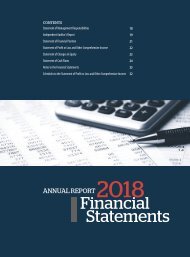You also want an ePaper? Increase the reach of your titles
YUMPU automatically turns print PDFs into web optimized ePapers that Google loves.
transforming the state of the t&T nation<br />
Economic Outlook<br />
A return to growth in<br />
2018?<br />
Speaking to the nation on<br />
television and radio in<br />
January, prime minister<br />
Keith Rowley promised “a<br />
slow return to growth” in 2018. The<br />
international agencies back him up. In<br />
its latest country report for <strong>Trinidad</strong><br />
and <strong>Tobago</strong> (November 2017), the IMF<br />
projected real GDP growth at 1.9 per<br />
cent this year. The CDB’s forecast was 1 2016<br />
per cent; UN ECLAC was less optimistic,<br />
forecasting a more conservative GDP<br />
growth rate of 0.5 per cent.<br />
The IMF predicted 7.7 per cent<br />
growth in the energy sector, thanks to<br />
the contributions of Juniper and the<br />
<strong>Trinidad</strong> Onshore Compression Project<br />
(TROC). But it thought the non-energy<br />
sector likely to contract by 1.2 per cent<br />
– cause for concern, as that sector makes up around 65 per<br />
cent of GDP, and non-energy export growth is vital for the<br />
country’s future.<br />
In estimating energy output for 2018, the IMF put the<br />
new norm of natural gas production in the range of 3-4 bcf<br />
per day, while oil production was expected to continue its<br />
decline, hitting record lows of 60,000-70,000 barrels per day.<br />
n of crude (bpd)<br />
s (bn cf)<br />
3.3<br />
3.8<br />
as a percentage<br />
t revenue<br />
3.0<br />
16<br />
Latin $3.7 America and Caribbean<br />
Overall, Latin America and the Caribbean are expected to see<br />
about 1.9 per cent growth in 2018. According to the IMF,<br />
growth in Central America has been strengthening; but in the<br />
2017<br />
Caribbean, domestic demand is expected to underperform,<br />
with growth of 2.3 per cent for tourism-dependent economies<br />
and 2.0 per cent for commodity exporters.<br />
n Khan at 2017 Energy Conference<br />
Debt to GDP ratio<br />
Debt<br />
In Antigua and Barbuda, Grenada, Jamaica, and St Kitts and<br />
Nevis, government debt-to-GDP ratios have been declining,<br />
reflective of fiscal discipline and debt restructuring. However,<br />
Barbados, The Bahamas, Suriname and <strong>Trinidad</strong> and <strong>Tobago</strong><br />
failed to sufficiently address their stubborn fiscal deficits<br />
and high debt levels, leading to downgrades by international<br />
credit agencies in 2016-17.<br />
According to the IMF, public sector debt remains a major<br />
vulnerability for the region. Barbados and Jamaica still have<br />
debt levels of over 100 per cent of GDP (102.7 and 109.5 per<br />
cent for 2017, respectively). However, they both reduced their<br />
debt levels, as did Antigua and Barbuda, Dominica, and St Kitts<br />
and Nevis. Declines in commodity prices exposed weaknesses<br />
2017<br />
<strong>Trinidad</strong> & <strong>Tobago</strong> GDP growth<br />
3<br />
2<br />
1<br />
0<br />
-1<br />
-2<br />
-3<br />
-4<br />
-5<br />
-6<br />
2013<br />
2014<br />
2015<br />
2016<br />
Caribbean Sustainable Energy Roadmap and<br />
Strategy (C-SERMS) RE goal:<br />
20% by 2017<br />
T&T RE goal:<br />
vital for the country’s future<br />
28% by 2022<br />
47% by 2027<br />
10% by<br />
in the fiscal policies of commodity exporters such as <strong>Trinidad</strong><br />
and <strong>Tobago</strong> and Suriname, leading to large fiscal 2021 deficits and<br />
increases in public debt.<br />
“Renewable sources of energy are the way forward”<br />
– Robert Le Hunte, Public Utilities Minister, January 2018<br />
2017<br />
Non-energy export growth is<br />
The global outlook<br />
In its World Economic Outlook Update for January 2018, the<br />
IMF estimated global economic growth for 2018 at 3.9 per<br />
cent, a slight improvement of 0.2 per cent over the previous<br />
October’s forecast. This continues the global economic trend<br />
of steady but modest recovery since 2016.<br />
US and UK<br />
The US economy was projected to grow by 2.7 per cent in 2018<br />
and 2.5 per cent in 2019, following reforms to US corporate<br />
and personal income taxes approved in December 2017.<br />
The Brexit aftermath has created much uncertainty over<br />
issues like trade and cross-border financial activity, which<br />
impacts the growth prospects of the United Kingdom. UK<br />
economic growth remains sluggish, and is projected at 1.5 per<br />
cent in 2018.<br />
China and Russia<br />
China’s economy is expected to grow by 6.5 per cent, which is<br />
an upward revision of 0.2 per cent as a result of a continued<br />
expansionary policy.<br />
In an attempt to clear the existing supply glut of oil, both<br />
OPEC and Russian-led non-OPEC producers are expected to<br />
extend production cuts to the end of 2018. The resulting oil<br />
and natural gas production levels are expected to produce a<br />
higher-priced environment as 2018 progresses.<br />
38<br />
<strong>Trinidad</strong><br />
and <strong>Tobago</strong> Chamber<br />
of Industry and Commerce<br />
www.chamber.org.tt/contact-magazine

















